Auteur/autrice : C&A HD
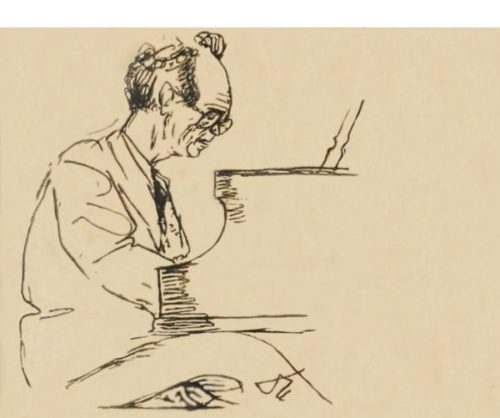
Rudolf Serkin Steinway piano – Guido Cantelli New York Philharmonic (NYPO)
Mozart Concerto n°20 K. 466 (Cadenzas: Beethoven) – Carnegie Hall March 27, 1953
Beethoven Concerto n°1 Op.15 (Cadenza: Beethoven Version III) – Carnegie Hall March 29, 1953
Source: Bande / Tape – 19 cm/s / 7.5 ips
L’invitation de nombreux solistes faisait partie intégrante de la politique des programmes du New York Philharmonic (NYPO). Cantelli a commencé à diriger le NYPO en janvier 1952, et très vite, un nombre appréciable de grands pianistes se sont produits avec lui: successivement de 1952 à 1956, Rudolf Firkušný, Nicole Henriot-Schweitzer, Claudio Arrau, Rudolf Serkin, Robert Casadesus, Walter Gieseking et Wilhelm Backhaus, et une série d’enregistrements radiophoniques nous permet d’apprécier ses qualités exceptionnelles en tant que partenaire, bien plus qu’accompagnateur.
Rudolf Serkin a fêté son cinquantième anniversaire le 28 mars 1953. Avec Guido Cantelli et le NYPO, il a joué les 26 et 27 le Concerto n°20 K.466 de Mozart et le 29, le Concerto n°1 Op.15 de Beethoven. Le jour même de son anniversaire, il a répété le concerto de Beethoven avec l’orchestre.
D’habitude, la Radio ne retransmet que le concert du dimanche dont le programme, comme ici, diffère de ceux qui ont été joués au cours de la semaine. Nous avons cependant la chance d’avoir un enregistrement du concerto de Mozart joué le vendredi 27.
Les critiques musicaux new-yorkais se sont accordés pour trouver mémorable l’interprétation par Serkin du concerto de Mozart et pour louer la direction de Cantelli.
Harris Goldsmith, qui a assisté au concert du 29 alors qu’il était encore étudiant en piano, a relaté bien plus tard à quel point l’interprétation beethovénienne de Serkin, portée par les tempi rapides et fougueux de Cantelli, qui lui rappelaient ceux de Toscanini (avec Ania Dorfmann), était à la fois musicale et intense.
On notera dans le largo du concerto de Beethoven la finesse du dialogue entre le piano et le clarinettiste solo du NYPO, Robert Mc Ginnis.

Inviting a large number of soloists was an integral part of the schedule of the New York Philharmonic (NYPO). Cantelli started conducting the NYPO in January 1952, and very soon, a significant number of great pianists performed with him: successively from 1952 to 1956, Rudolf Firkušný, Nicole Henriot-Schweitzer, Claudio Arrau, Rudolf Serkin, Robert Casadesus, Walter Gieseking and Wilhelm Backhaus, and a series of broadcast recordings allows us to appreciate his exceptional qualities as a partner, rather than an accompanist.
Rudolf Serkin’s fiftieth birthday was on March 28, 1953. With Guido Cantelli and the NYPO, he played Mozart’s Concerto n°20 K.466 on the 26 and 27, and on the 29, Beethoven’s Concerto n°1 Op.15. On the birthday itself, he rehearsed the Beethoven concerto with the orchestra.
Usually, the Radio broadcasts only the Sunday concert whose program, as here, is different from those that have been played during the week. We are however lucky to have a recording of the Mozart’s concerto played on the Friday 27.
New York music critics agreed to find Serkin’s performance of the Mozart concerto memorable and to praise Cantelli’s conducting.
Harris Goldsmith, who attended the concert on the 29 when he was still a piano student, remembered many years later to what extend Serkin’s Beethoven performance, uplifted by Cantelli’s fast and fiery tempi, which reminded him of Toscanini’s (with Ania Dorfmann), was both musical and intense.
Note in the largo of the Beethoven’s concerto the delicacy of the dialog between the piano and the solo clarinettist of the NYPO, Robert Mc Ginnis.
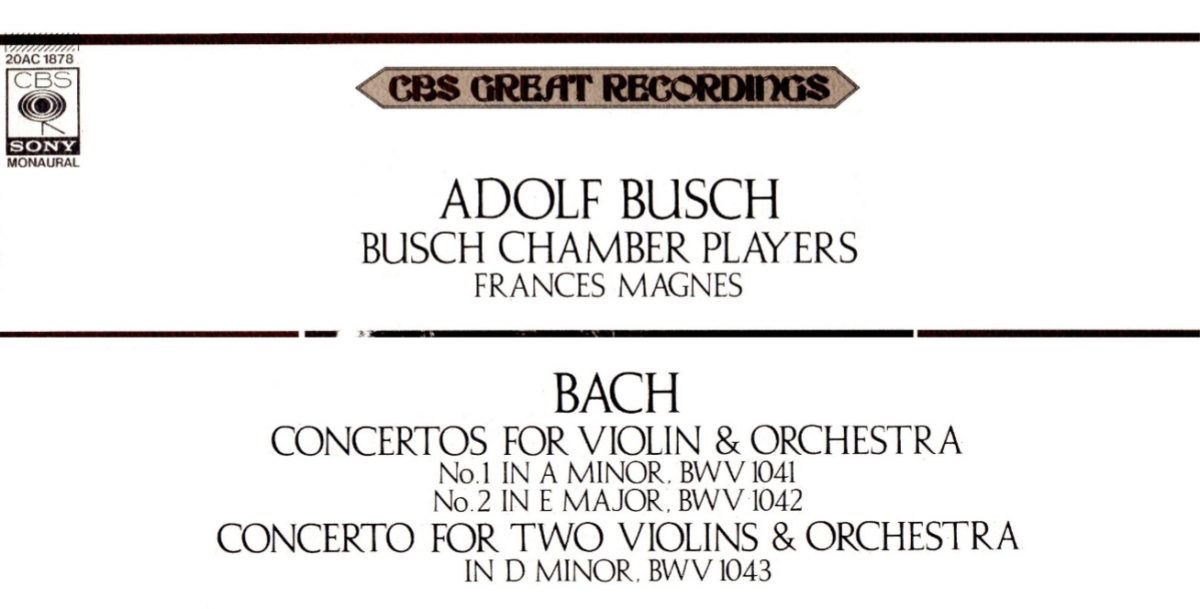
Concerto n°1 BWV 1041: New York Town Hall – March 26, 1943 (Live) Lukas Foss, piano (continuo)
Concerto n°2 BWV 1042: New York Liederkranz Hall – May 25, 1942 Artur Balsam, piano (continuo)
Concerto for 2 Violins BWV 1043 (Frances Magnes, violin II): New York Liederkranz Hall – April 26 & May 3, 1945
Source: 33t. / LP: CBS Sony 20AC 1878
Ces enregistrements nous permettent de redécouvrir le style inimitable d’ Adolf Busch dans ces concertos.
Dans les mouvements rapides, il fait un abondant usage du staccato, ce qui, combiné avec son l’énergie de son jeu et de sa conduite de l’orchestre, apporte une tension et un rebond rythmique que l’on ne retrouvera à ce point que très longtemps plus tard avec Gidon Kremer, la majeure partie des interprétations, même des plus grands violonistes, s’en tenant à un legato en général bien décevant.
Dans les mouvements lents, son style fait également merveille, comme le rapportait à propos de l’Adagio du Concerto BWV 1042 dans le New York Times du 16 avril 1942 le critique Noel Straus après le concert du 15 avril donné un peu plus d’un mois avant cet enregistrement: « Une présentation plus noble et avec plus d’âme de ce mouvement est difficilement imaginable, ni une plus remarquable pour sa pureté et sa chaleur de son ».
Il est regrettable que Busch n’ait pas eu l’opportunité d’enregistrer en studio le concerto BWV 1041, mais une captation en public réalisée en 1943 au Town Hall de New York a été conservée. Même si elle a été réalisée sur des 78 tours à gravure directe, sa qualité technique est satisfaisante, nonobstant un niveau de distorsion élevé.
Quant aux deux autres enregistrements, ils proviennent de laques 33 tours 40cm, technique que Columbia utilisait systématiquement depuis 1939 pour archiver ses enregistrements, les matrices métalliques pour les disques 78 tours du commerce étant à l’époque gravées à partir de ces laques 33 tours.

Adolf Busch
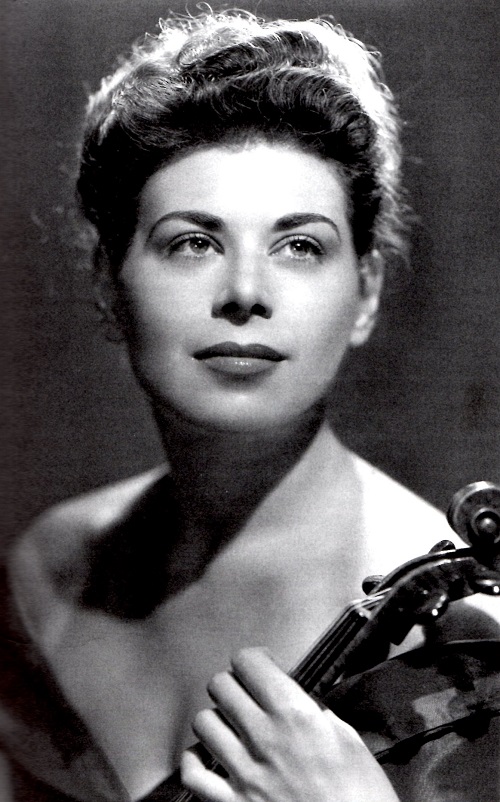
Frances Magnes
These recordings allow us to rediscover Adolf Busch’s inimitable style in these concertos.
In the fast movements, he makes extensive use of staccato, which, in combination with the energy in his playing and in his conducting, brings a tension and a rhythmic bounce which will not be found again to that extend until much later with Gidon Kremer, most of the performances, even from the greatest violonists, relying on a generally disappointing legato.
In the slow movements, his style works wonders too, as was then observed about the Adagio of the concerto BWV 1042 in the April 16, 1942 issue of the New York Times by music critic Noel Straus after his April 15 concert given a little more than a month before this recording: « A more soulful, noble presentation of this movement is not easily imaginable, or one more remarkable for purity and warmth of tone ».
It is regrettable that Busch didn’t have the opportunity of making a studio recording of concerto BWV 1041, but a live recording made in 1943 at the Town Hall of New York has been preserved. Even if it was made on 78rpm ‘acetates’, its technical quality is satisfactory, notwithstanding a high distortion level.
As to the other two recordings, they are dubbed from 33rpm 16’’ lacquers, a technique which Columbia systematically used since 1939 for the masters of its recordings, the 78rpm metal parts for the commercial 78rpm shellacks being thereafter cut from these 33rpm lacquers.
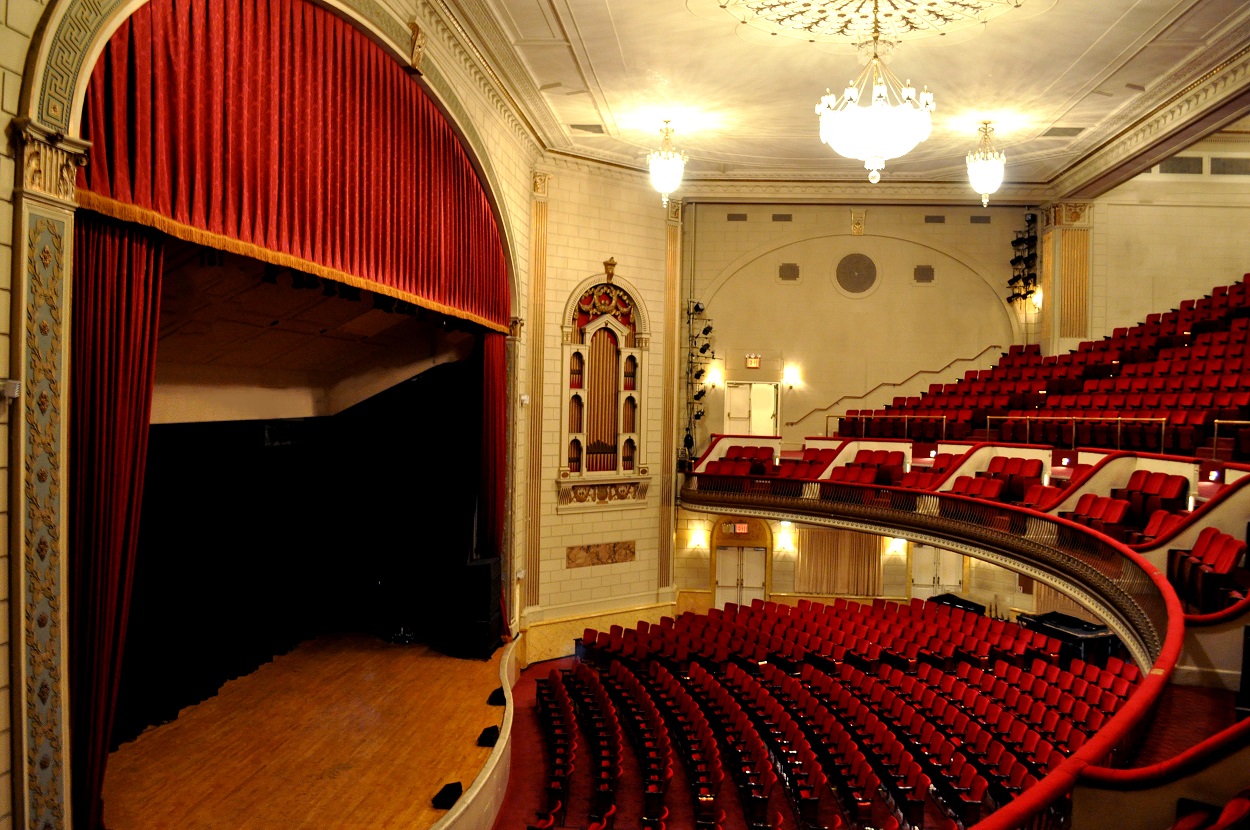
Town Hall – New York
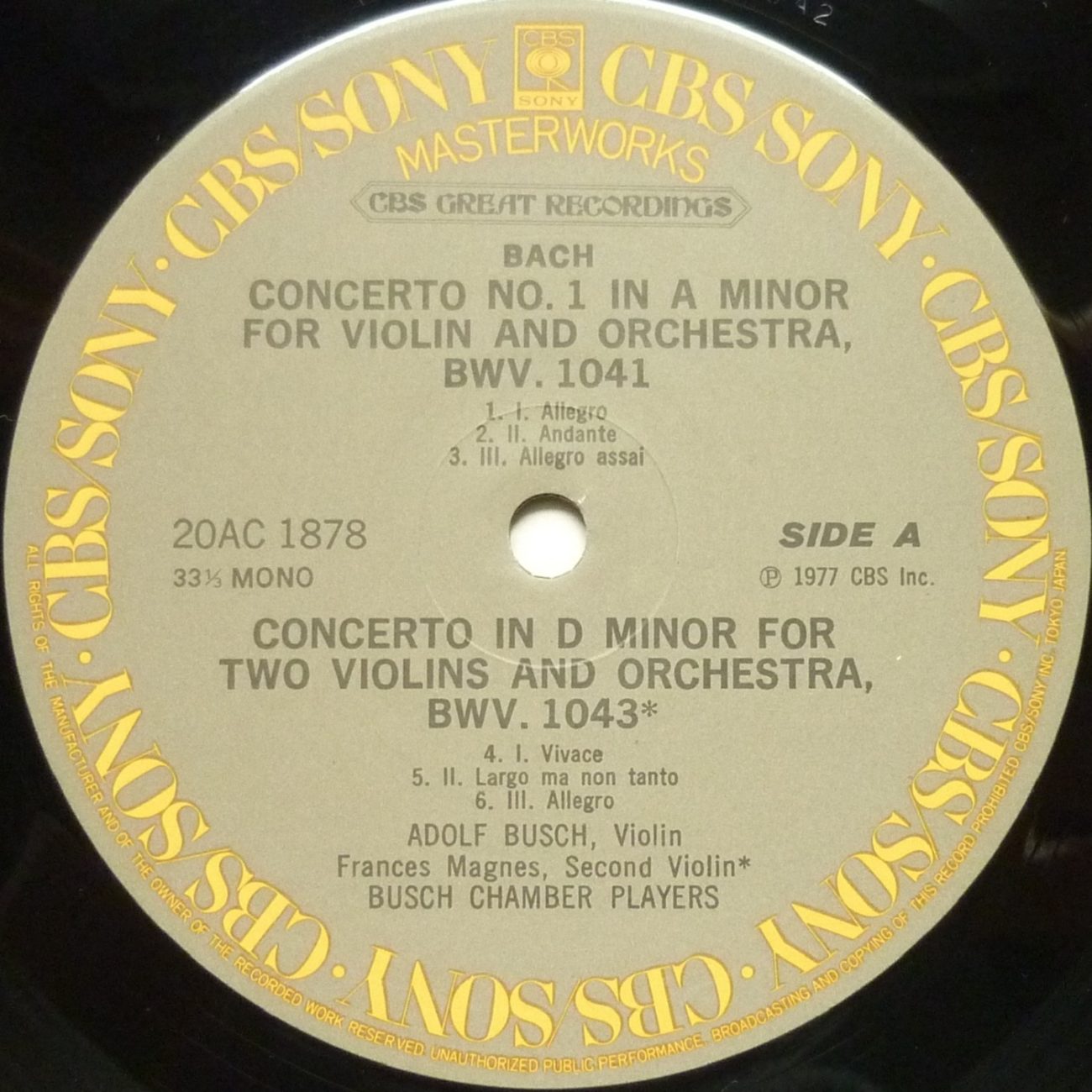


Cadences/Cadenzas: Ferrucio Busoni
Walter Gieseking, Baldwin piano – Guido Cantelli New York Philharmonic (NYPO)
Carnegie Hall – March 6, 1955
Source: Bande / Tape – 19 cm/s / 7.5 ips
Cette interprétation du 6 octobre 1955 documente la rencontre entre Gieseking et Cantelli. C’est le retour de Gieseking avec le NYPO pour la première fois depuis 1939, et c’est une réussite. L’influence réciproque entre les deux interprètes conduit à une interprétation mémorable qui est on ne le peut mieux décrite que par le critique américain Bernard H. Haggin (1900-1987) dans son article de 1968 en hommage à Cantelli:
‘A l’époque, j’ai trouvé que beaucoup d’interprétations de Cantelli étaient merveilleuses; et merveilleux est le mot pour certaines que j’ai entendues récemment, en particulier celle du Concerto pour piano de Mozart K.467. Dans mon expérience, seul Toscanini apportait aux solistes des contextes orchestraux aussi beaux et aussi efficaces que ceux de Cantelli; et dans mon expérience, Toscanini a fourni le précédent pour la chose extraordinaire qui se passe dans l’interprétation par Cantelli du concerto K.467. A un concert du New York Philharmonic en 1934, j’ai entendu Toscanini diriger les concertos K.467 et K.466 avec José Iturbi en soliste, et j’ai entendu Iturbi—sous l’impulsion de la personnalité et du magnétisme du chef—rivaliser avec le jeu puissant de l’orchestre avec un jeu personnel qui était remarquablement différent de son jeu embelli habituel, un style de salon, pour jouer Mozart.
Et la même chose se produit dans l’exécution par Cantelli du concerto K.467. Ce que l’on s’attend à entendre après l’introduction orchestrale superbement exécutée est le style miniature finement ciselé pour jouer Mozart que l’on entend toujours de la part de Gieseking; mais ce que l’on entend à la place, ce sont une énonciation forte et des phrasés forts pour jouer la mélodie, et des doigtés forts pour les séquences de notes rapides et les figurations qui doivent avoir surpris Gieseking comme ils doivent avoir surpris ses auditeurs en 1955 au concert du New York Philharmonic. Jamais auparavant, il n’avait joué Mozart comme cela; et il l’a fait sous la même impulsion de la part de Cantelli que celle que Toscanini avait exercé sur Iturbi. Sous cette impulsion, Iturbi a réussi, et Gieseking réussit, dans l’extraordinaire Andante ce que je n’ai entendu d’aucun autre pianiste au concert: une énonciation et une articulation de la longue cantilène du piano qui soit comparable avec l’enregistrement discographique de Schnabel. Et le jeu de Gieseking dans cette cantilène, contrairement à celui de Schnabel, s’exprime dans le contexte du jeu superbe de la partie orchestrale qui est constamment active—par exemple, les commentaires poignants des bois qui intensifient certaines des énonciations du piano.’

![]()

This October 6, 1955 concert illustrates the meeting between Gieseking and Cantelli. It is Gieseking’s return with the NYPO for the first time since 1939 and it is a success. The reciprocal influence between both musicians leads to a memorable performance best described by US critic Bernard H. Haggin (1900-1987) in his 1968 tribute to Cantelli:
‘Many of Cantelli’s performances I found marvelous at the time; and marvelous is the word for those I have heard recently—in particular the one of Mozart’s Piano Concerto K.467. Only Toscanini, in my experience, provided soloists with orchestral contexts as beautifully made and as effective as Cantelli’s; and Toscanini provided the one precedent in my experience for the astounding thing that happens in Cantelli’s performance of K.467. At a New York Philharmonic concert in 1934, I heard Toscanini perform K.467 and 466 with José Iturbi as soloist, and heard Iturbi—under the compulsion of the personality and magnetism of the man on the podium—match the orchestra’s powerful playing with playing of his own that was strikingly different from his customary prettified salon-style playing of Mozart.
And the same thing happens in Cantelli’s performance of K.467. What one expects to hear after the superbly performed orchestral introduction is the finely chiseled miniature-scale playing of Mozart that one always heard Gieseking do; but what one hears instead is a strongly enunciated, strongly phrased playing of melody, a strong-fingered execution of runs and figuration, that may have amazed Gieseking as it must have amazed his listeners at the New York Philharmonic concert in 1955. He had never played Mozart that way before; and he did so then under the same compulsion from Cantelli as Toscanini had exercised on Iturbi. Under that compulsion, Iturbi achieved, and Gieseking achieves, in the extraordinary Andante what I have heard live from no other pianist: an enunciation and articulation of the piano’s long cantilena comparable with Schnabel’s in his recorded performance. And Gieseking’s playing of this cantilena, unlike Schnabel’s, is heard in the context of the superb playing of the constantly active orchestral part—e.g., the poignant woodwind comments intensifying certain of the piano’s statements.’

Sérénade pour orchestre à cordes Op.22 – Václav Talich Prague Soloists’ Orchestra
Enr/Rec: Salle Dvořák (Rudolfinum) – 28 Avril 1951
Sérénade pour instruments à vent, violoncelle et contrebasse Op. 44
Professorum Conservatorii Pragensis Societas Cameralis
Enr/Rec:1951
Source: 33t/LP Supraphon SUA 10326
Les deux Sérénades de Dvořák sont des œuvres magnifiques qui ne sont pas données assez souvent au concert.
Talich nous en livre son interprétation de référence avec un orchestre de chambre qui a été constitué à l’époque à Prague pour réaliser des enregistrements discographiques. Il avait certes fondé l’Orchestre de Chambre Tchèque en 1946 avec des étudiants du Conservatoire de Prague, mais l’ensemble a été contraint de se dissoudre en 1948.
La ‘Societa Cameralis’, ensemble qui regroupait des professeurs du Conservatoire de Prague, pour l’essentiel des instrumentistes à vent, et aussi chefs de pupitres des orchestres pragois, en somme un équivalent du ‘Wiener Oktett’, a été constitué en 1951 par le hautboïste Adolf Kubát (1899-1980). Il a joué dans de nombreux pays un répertoire étendu qui comprenait également des œuvres des anciens compositeurs tchèques et des compositions contemporaines. Son interprétation est bien dans la lignée de celle de Talich.
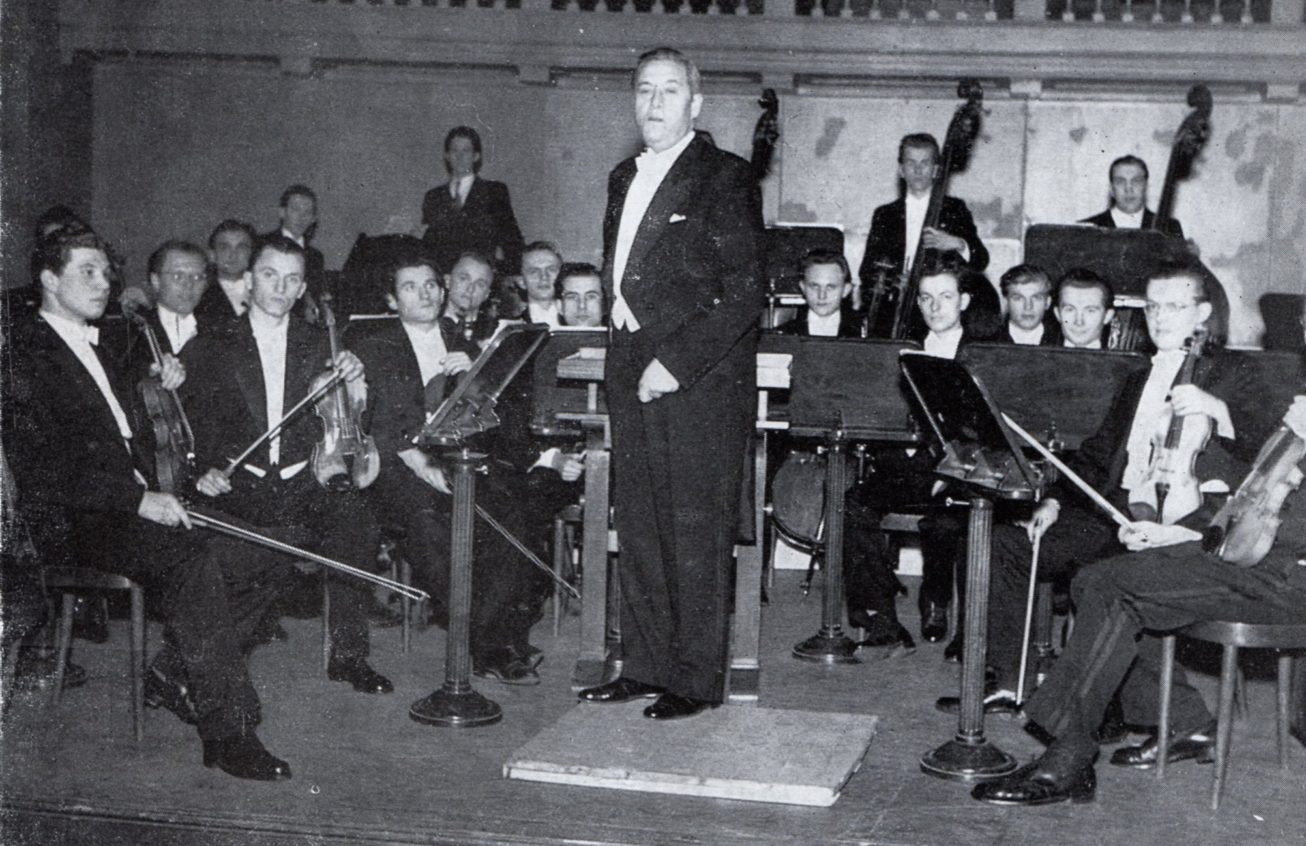
Václav Talich – Orchestre de Chambre Tchèque/Czech Chamber orchestra (1947)
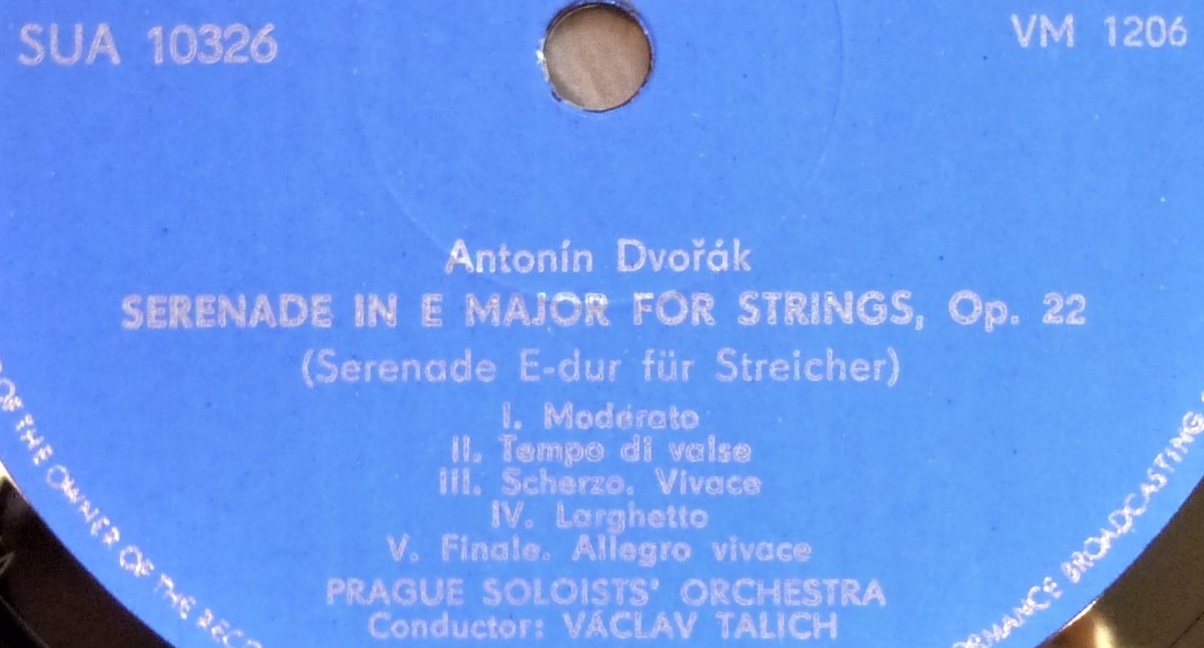

Dvořák’s two Serenades are wonderful works that are not performed often enough.
Talich gives us a reference performance with a chamber orchestra which was then built up in Prague for commercial recordings. Indeed, he established the Czech Chamber Orchestra in 1946 with students from the Prague Conservatory, but it was obliged to disband in 1948.
The ‘Societa Cameralis’, made up of teachers of the Prague Conservatory, mainly wind players, and also first desks of the Prague orchestras, thus a kind of Czech equivalent of the ‘Wiener Oktett’, was grounded in 1951 by oboist Adolf Kubát (1899-1980). It has performed in various countries a large repertoire which also included works by old Czech masters as well as modern compositions. Its performance is well in line with Talich’s.

Václav Talich (1942)

Kathleen Ferrier
Brahms Alt-Rhapsodie Op.53: Chœur d’Hommes et Orchestre de la Radio Danoise (Symfoniorkestret /Statsradiofoniens Mandskor: Svend S. Schultz)
dir: Fritz Busch
2 Lieder: Von ewiger Liebe Op43-I – Wir wandelten Op96-II Phyllis Spurr, piano
Radio Studio n°1 – 6 octobre 1949 Source: 33t/LP Danacord DACO 114
___________
Mahler Kindertotenlieder: WPO Bruno Walter
Kingsway Hall 4 octobre 1949
Prod: Walter Legge/Leonard Smith – Eng: Douglas Larter
Source 33t/LP: Angel Japan EAC-57048
En l’espace de deux jours, Kathleen Ferrier nous a offert deux enregistrements majeurs.
Tout d’abord à Londres où le Philharmonique de Vienne (WPO) était présent du 28 septembre au 6 octobre 1949 au cours d’une tournée dirigée par Furtwängler qui rejoindra ensuite Paris, Genève et Zürich.
Ferrier et Walter, de retour d’Edimbourg, ont donné à Londres les 1 et 2 octobre deux concerts Mahler avec les Kindertotenlieder et la Deuxième Symphonie (BBC SO and Choral Society).
Le 4, Furtwängler a dirigé avec le WPO un concert Brahms avec Menuhin, et une séance d’enregistrement a pu être programmée l’après-midi (14h30-17h30) au Kingsway Hall pour capter les Kindertotenlieder avec Bruno Walter.
Walter dirigea un concert londonien avec le WPO le 6. Mais, ce fut sans Ferrier qui chantait ce jour-là la ‘Alt-Rhapsodie’ avec Fritz Busch à Copenhague. De toutes façons, avec le WPO à Londres, elle n’aurait pas pu chanter l’œuvre de Brahms : Furtwängler avait déjà mis la ‘Alt-Rhapsodie’ au programme de son concert du 28 septembre (avec Mary Jarred).
Le programme dirigé par Fritz Busch avec son Orchestre de la Radio Danoise comprenait la Symphonie n°7 Op.70 de Dvorak (à l’époque dénommée ‘n°2’ comme lors de sa publication), et en deuxième partie, un ou plusieurs airs de l’ ‘Orphée’ de Gluck, puis la Rhapsodie Op.53 de Brahms et enfin les Métamorphoses d’Hindemith:
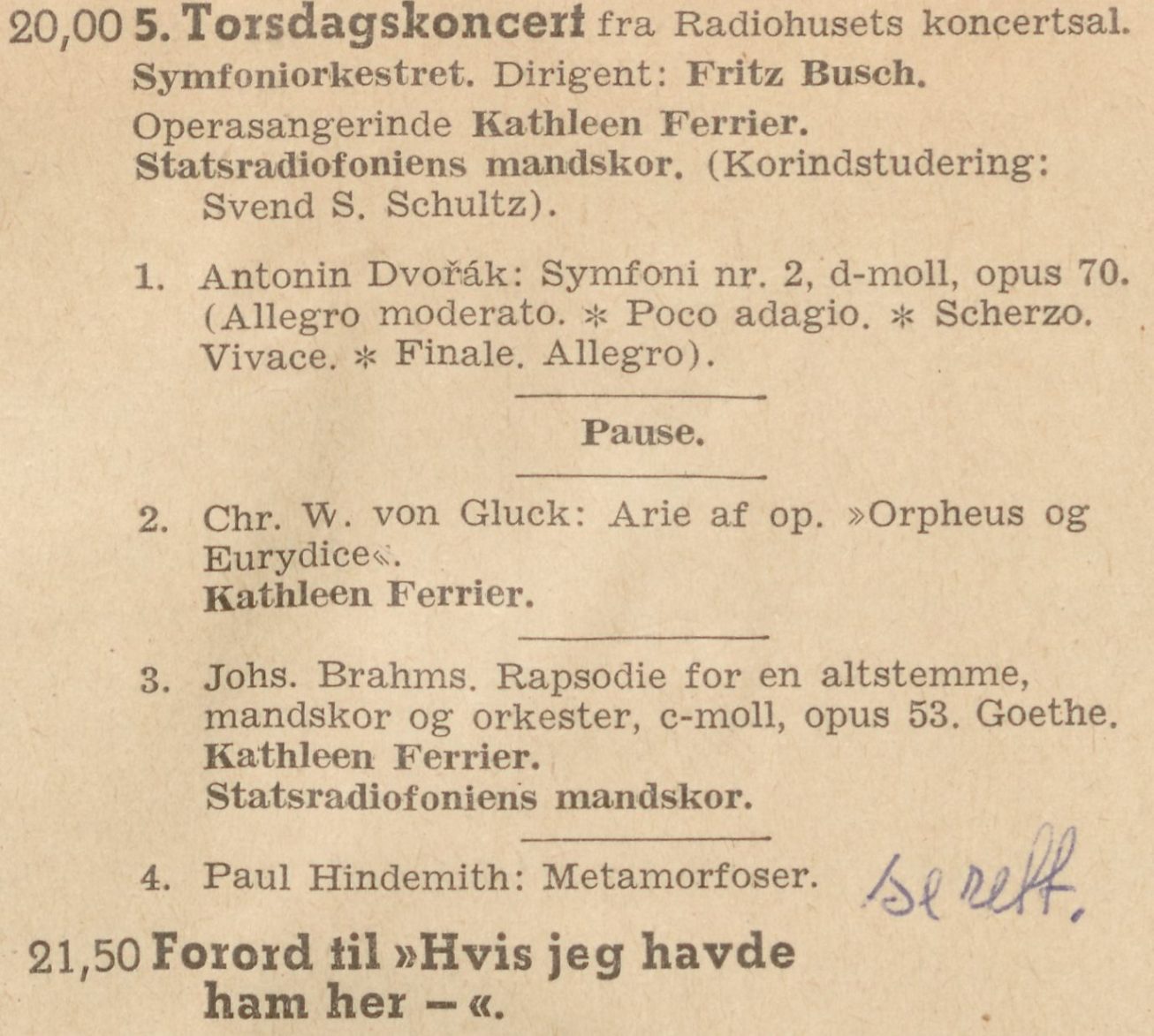
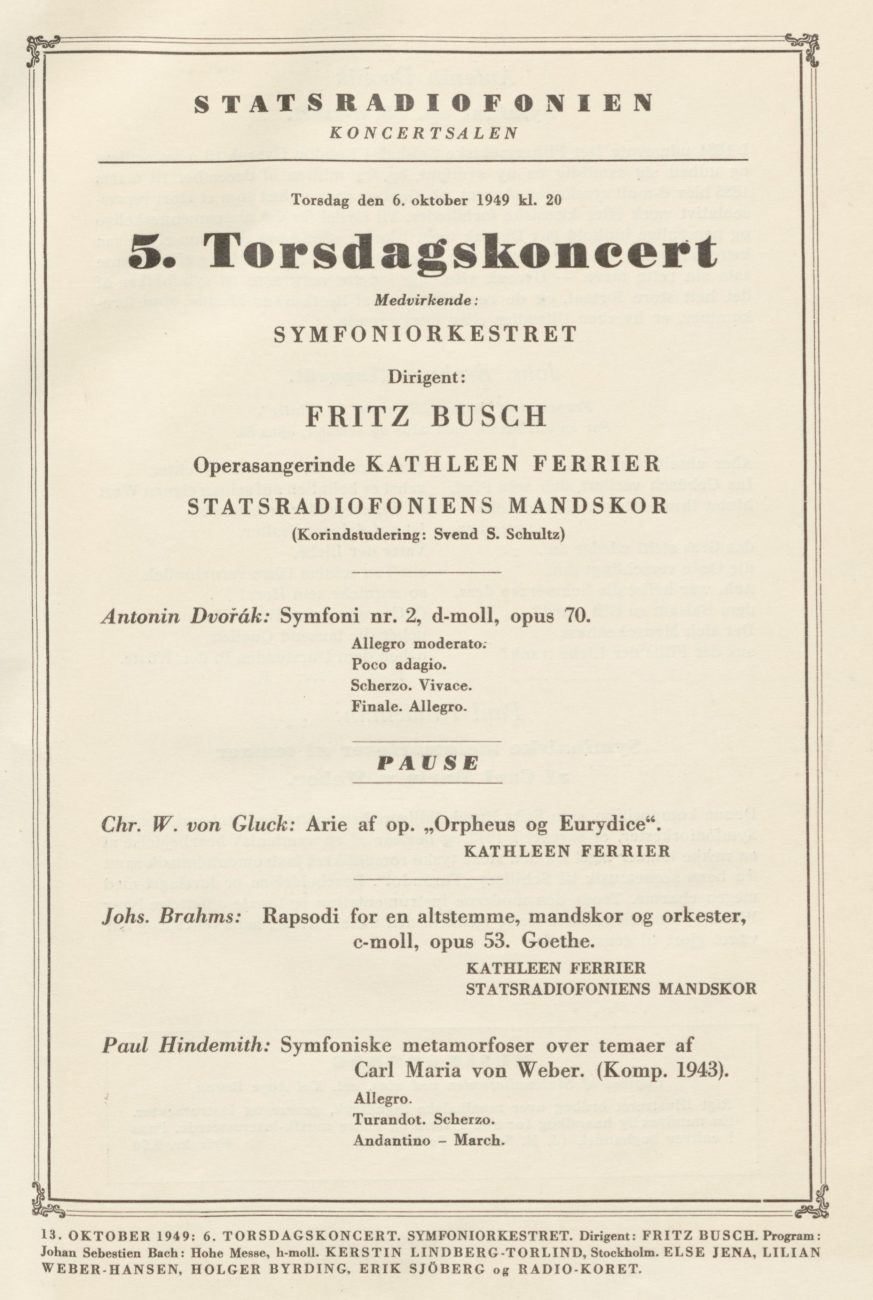
On voit que les deux Lieder de Brahms, probablement joués en bis, dans lesquels Ferrier est accompagnée par sa pianiste venue spécialement pour sa tournée en Scandinavie, ne figurent pas dans ce programme officiel. On les trouve par contre avec Gluck dans une feuille annexe de la Radio:

L’enregistrement de la Rhapsodie Op.53 a été complété par des sources provenant d’enregistrements privés de l’émission de la Radio Danoise pour compenser les parties dégradées de l’archive officielle. Les deux Lieder sont incomplets. Il manque les six premiers vers du premier Lied, et le début de l’introduction pianistique de l’autre.
Kathleen Ferrier et Fritz Busch se sont retrouvés avec l’Orchestre de la Radio Danoise au Festival d’Edimbourg, le 28 août 1950, avec le Royal Choral Union d’Edimbourg pour cette Rhapsodie Op.53.
Fritz Busch avait prévu de faire son grand retour à Berlin en mars 1952. A cette occasion, il avait invité Kathleen Ferrier à ses concerts qui devaient avoir lieu avec les 16 et 17 mars avec l’Orchestre de la RIAS. Sa disparition en septembre 1951 a réduit ce projet à néant.
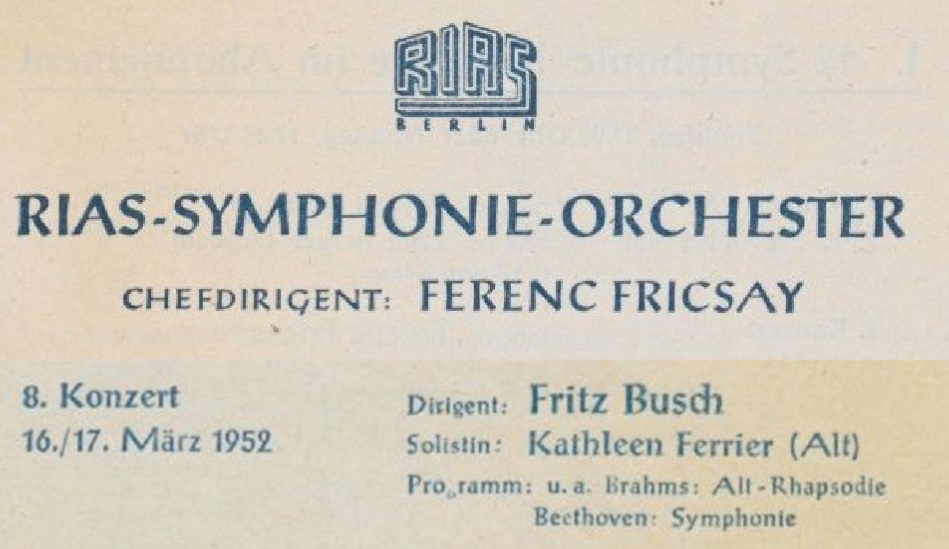
____________

____________
Within two days, Kathleen Ferrier offered us two major recordings.
To start with, in London where the Vienna Philharmonic (WPO) was present between 28 September to 6 October during a tour conducted by Furtwängler which later joined Paris, Geneva and Zürich.
Ferrier and Walter, back from d’Edinburgh, gave on October 1 and 2 two Mahler concerts in London with the Kindertotenlieder and the Second Symphony (BBC SO and Choral Society).
On the 4th, Furtwängler conducted a Brahms concert with Menuhin and the WPO, and an afternoon recording session (2.30pm – 5.30pm) has been set at Kingsway Hall to record the Kindertotenlieder with Bruno Walter.
Walter took the opportunity of being in London to conduct one concert with the WPO on the 6th. But it was without Ferrier who, on that very day, sang the ‘Alt-Rhapsodie’ with Fritz Busch in Copenhagen. Anyway, with the WPO in London, she might not have sung the work by Brahms : Furtwängler already put the ‘Alt-Rhapsodie’ at the program of his concert on 28 September (with Mary Jarred).
The programme conducted by Fritz Busch and his Orchestra of the Danish Radio was comprised of Dvorak’s Symphony n°7 Op.70 (then named ‘n°2’ as when it was published), and for the second part, Arias from Gluck’s Orpheus, then the Rhapsodie Op.53 by Brahms and to end with, Hindemith’s Metamorphosen:

We see that the two Brahms’Lieder, probably performed as encores, in which Ferrier is accompanied by her pianist who came especially for her Scandinavian tour, are not mentioned in this official programme. They are however found with the Gluck item in an extra Radio programme sheet:

The recording of the Rhapsody Op.53 was completed by private sources coming from the broadcast of the Danish Radio Danoise to compensate for the unusable parts of the official archive. Both Lieder are incomplete. The six first verses of the first Lied are missing, as well as the beginning of the piano introduction of the second.
Kathleen Ferrier and Fritz Busch met again with the Danish Radio Orchestra at the Edinburgh Festival on 28 August 1950, with the Edinburgh Royal Choral Union for this Rhapsody Op.53.
Fritz Busch scheduled his postwar return to Berlin for March 1952. He seized the opportunity for inviting Kathleen Ferrier to his concerts that were to take place on 16 and 17 March with the RIAS Orchestra. His death in September 1951 ruined this project.




